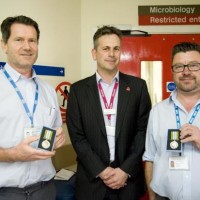The UK Government issued a call for suitably experienced scientists to help with the mounting humanitarian crisis in West Africa caused by the Ebola outbreak In October 2014. 9 volunteers from the Animal and Plant Health Agency (APHA) immediately offered their valuable laboratory skills.

After a week’s training the volunteers were flown out to work as part of a team of scientists and healthcare specialists at 2 British built sites in Sierra Leone, namely the Mateneh Ebola Treatment Centre, run by the International Medical Corps and a treatment centre in Port Loko, run by the charity GOAL. Both centres also housed diagnostic laboratories which had been set up by Public Health England.
APHA Chief Executive, Chris Hadkiss, presenting some of the volunteers with their medals, commented: “To volunteer to travel to an Ebola infected country, in support of the humanitarian work, was an incredibly selfless act and I commend everyone’s bravery and dedication.
“It is thanks to the efforts of all these volunteers, working alongside local healthcare workers that so many areas have been declared Ebola free and so many lives have been saved.”
The special medal, approved by Her Majesty The Queen, was awarded to those military and civilian personnel who supported the government’s response to the Ebola crisis that began in 2014. People who have received the medal include armed forces personnel, doctors and nurses from the NHS, scientists and public health specialists and members of the civil service and non-governmental organisations.
Virologist Anna La Rocca found it a difficult but rewarding experience: “When we arrived, our main job was to test patient samples and get accurate results as soon as possible so that people could be treated or released. We also had to quickly test samples from the surrounding community to allow a rapid response to any new outbreak.”
Bacteriologist Roland Ashford commented: “The Mateneh diagnostic laboratory was of a good standard, given the location and the speed with which it had to be constructed. It had to be staffed for 16 hours a day, every day of the week in order to meet the demands for testing samples from the community.”
Biochemist Gareth Williams added: “The location of the laboratory within the Mateneh ETC meant samples could be submitted directly and the results made available within four hours. This was crucial in allowing the medical teams to decide how patients should be managed.
“The laboratory was also used to establish when convalescing patients were no longer infectious and could be released from the treatment centre. These patients would mark their recovery by leaving a handprint on a ‘Survivors’ Wall’, which in itself was a very moving reminder of the seriousness of the outbreak.”








